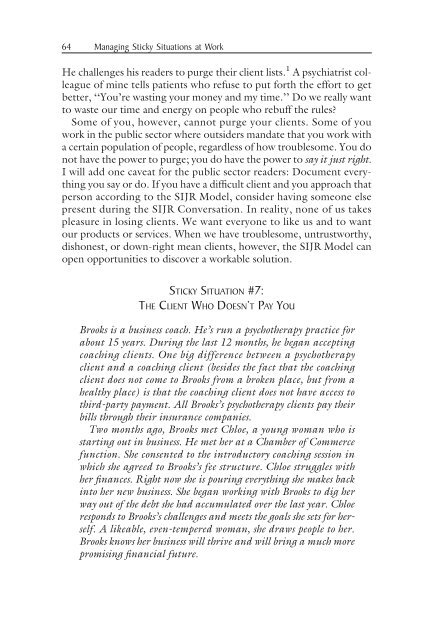Managing Sticky Situations at Work
Managing Sticky Situations at Work
Managing Sticky Situations at Work
You also want an ePaper? Increase the reach of your titles
YUMPU automatically turns print PDFs into web optimized ePapers that Google loves.
64 <strong>Managing</strong> <strong>Sticky</strong> <strong>Situ<strong>at</strong>ions</strong> <strong>at</strong> <strong>Work</strong>He challenges his readers to purge their client lists. 1 A psychi<strong>at</strong>rist colleagueof mine tells p<strong>at</strong>ients who refuse to put forth the effort to getbetter, ‘‘You’re wasting your money and my time.’’ Do we really wantto waste our time and energy on people who rebuff the rules?Some of you, however, cannot purge your clients. Some of youwork in the public sector where outsiders mand<strong>at</strong>e th<strong>at</strong> you work witha certain popul<strong>at</strong>ion of people, regardless of how troublesome. You donot have the power to purge; you do have the power to say it just right.I will add one cave<strong>at</strong> for the public sector readers: Document everythingyou say or do. If you have a difficult client and you approach th<strong>at</strong>person according to the SIJR Model, consider having someone elsepresent during the SIJR Convers<strong>at</strong>ion. In reality, none of us takespleasure in losing clients. We want everyone to like us and to wantour products or services. When we have troublesome, untrustworthy,dishonest, or down-right mean clients, however, the SIJR Model canopen opportunities to discover a workable solution.STICKY SITUATION #7:THE CLIENT WHO DOESN’T PAY YOUBrooks is a business coach. He’s run a psychotherapy practice forabout 15 years. During the last 12 months, he began acceptingcoaching clients. One big difference between a psychotherapyclient and a coaching client (besides the fact th<strong>at</strong> the coachingclient does not come to Brooks from a broken place, but from ahealthy place) is th<strong>at</strong> the coaching client does not have access tothird-party payment. All Brooks’s psychotherapy clients pay theirbills through their insurance companies.Two months ago, Brooks met Chloe, a young woman who isstarting out in business. He met her <strong>at</strong> a Chamber of Commercefunction. She consented to the introductory coaching session inwhich she agreed to Brooks’s fee structure. Chloe struggles withher finances. Right now she is pouring everything she makes backinto her new business. She began working with Brooks to dig herway out of the debt she had accumul<strong>at</strong>ed over the last year. Chloeresponds to Brooks’s challenges and meets the goals she sets for herself.A likeable, even-tempered woman, she draws people to her.Brooks knows her business will thrive and will bring a much morepromising financial future.















